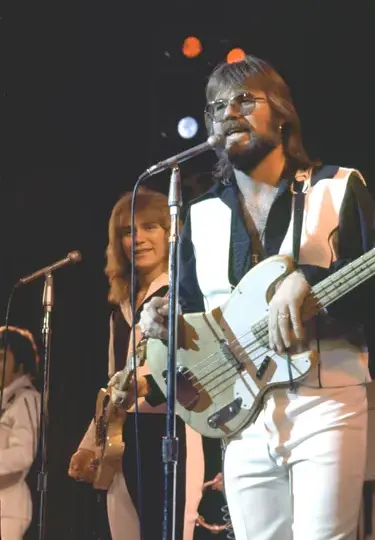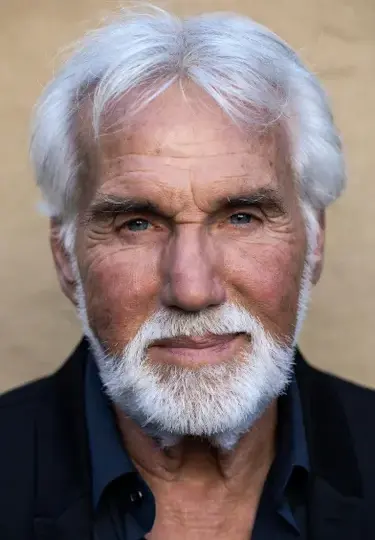From the moment Kenny Rogers stepped into the spotlight, his face became a visual chronicle of his journey in music. From a rising star in the 1960s to a legendary country music icon, the changes in his appearance were nearly as dramatic as his rise to fame. Fans watched as his once youthful features evolved over decades, reflecting both the natural passage of time and, later, the effects of cosmetic interventions. Today, artificial intelligence provides a striking glimpse of what Rogers might have looked like had he aged naturally, untouched by surgery, alongside archival images spanning his long career. This visual journey allows us to see not only the physical evolution of a beloved musician but also the human story behind those changes.
The Early Years: 1960s. In the 1960s, Kenny Rogers was nearly unrecognizable to the fans who would later know him as a polished country superstar. With tousled dark hair, a full beard, and amber-tinted aviator glasses, he exuded a quiet intensity and laid-back charm. Often seen in open-collared zip-up sweaters and casual attire, Rogers projected the image of an emerging folk-rock artist rather than the refined entertainer he would eventually become. His face was fresh, expressive, and full of youthful energy, reflecting a man just beginning to navigate the demands and excitement of the music industry.

Rise to Stardom: 1970s and 1980s
By 1979, Kenny Rogers had fully embraced his status as a mainstream country star. His hair, now feathered and silvered, framed a perfectly sculpted beard, and his skin appeared smoother, hinting at early cosmetic care. Rogers adopted a polished and controlled image that mirrored his chart-topping success. Tailored vests, crisp white shirts, and subtle gold jewelry became his signature look, projecting both confidence and sophistication. His evolving appearance reflected a combination of personal style, the pressures of fame, and a desire to present a consistent public image.
In the early 1990s, Rogers’ style became more theatrical. He often chose bold patterns, such as polka-dot shirts beneath blue velvet jackets, blending showmanship with refinement. His silver hair, neatly swept back, and carefully trimmed beard framed a familiar and approachable smile. While his appearance became more deliberate, it still retained the warmth and relatability that endeared him to millions of fans.
Cosmetic Changes: 2000s and Beyond
By 2003, subtle signs of cosmetic intervention became noticeable. His skin appeared smoother, particularly around the eyes and forehead, softening the natural effects of aging. While he maintained his full, white hair, the face he presented to the public had a slightly “airbrushed” quality, signaling surgical refinements. Over the following years, Rogers continued to carefully maintain this appearance, creating a polished image that drew attention both for its artistry and for its divergence from natural aging.

In 2012, Rogers’ facial changes became more pronounced. His skin looked taut, his eyes appeared lifted, and fine lines had largely disappeared. That same year, he reflected openly on his surgical decisions, admitting with surprising candor, “I was trying to hide myself. I regret that.” Despite working with highly skilled surgeons, he confessed uncertainty about the outcome, saying, “The truth is, I don’t know what I would have looked like if I hadn’t done it.”
By 2015, Rogers had grown comfortable with the public discourse surrounding his appearance. He embraced the humor in cosmetic surgery rumors, often laughing alongside friends and fans. Longtime friend Dolly Parton once teased him, saying, “Look, ol’ Kenny’s been to Jiffy Suck again,” before reassuringly adding, “I think he’s really grown into his facelift now.” Rogers responded with characteristic warmth, emphasizing that laughter and lightheartedness were central to his life, even amid scrutiny.
Rogers Reimagined: AI and the Untouched Face
In the years leading up to his death in March 2020, Kenny Rogers remained candid about his regrets regarding plastic surgery. His carefully maintained appearance had become part of the broader conversation about his legacy. In 2025, aesthetic surgeon Joel Kopelman offered insight into Rogers’ surgical history, noting that procedures around his eyes and brows appeared overly aggressive, leaving his face with a stretched and tense quality rather than a natural, relaxed look.

Thanks to AI, we can now visualize a version of Kenny Rogers as he might have appeared had he aged without surgical intervention. These reimagined portraits present a grounded, authentic version of the country icon. His skin shows natural creases and depth, his eyes convey expressive warmth, and his brows sit comfortably above his face. The result is a vision of Rogers that mirrors the soulful qualities of his music: quiet strength, kindness, and the passage of time reflected gracefully in every line and shadow.
Legacy Beyond Appearance
Although Kenny Rogers’ face evolved in ways both natural and surgical, his voice and musical legacy remained untouched. From his earliest recordings to his final performances, the emotional honesty, warmth, and humanity in his music endured. The combination of archival photos and AI-generated portraits tells a story not just about cosmetic choices but about the pressures of a life lived in the spotlight, and the universal human desire to maintain control over one’s image as the years pass.
In the end, Kenny Rogers’ true timelessness was never in the smoothness of his skin or the perfection of his features. It was in his music, his laughter, his kindness, and the way he connected with millions of fans worldwide. No surgery, no matter how meticulous, could overshadow the qualities that made him a legend. Through both real photographs and AI reimaginations, we are reminded that the essence of Kenny Rogers was always far more than the face in front of the cameras—it was the heart, soul, and artistry that will continue to inspire generations.
From the moment Kenny Rogers stepped into the spotlight, his face became a visual chronicle of his journey in music. From a rising star in the 1960s to a legendary country music icon, the changes in his appearance were nearly as dramatic as his rise to fame. Fans watched as his once youthful features evolved over decades, reflecting both the natural passage of time and, later, the effects of cosmetic interventions. Today, artificial intelligence provides a striking glimpse of what Rogers might have looked like had he aged naturally, untouched by surgery, alongside archival images spanning his long career. This visual journey allows us to see not only the physical evolution of a beloved musician but also the human story behind those changes.
The Early Years: 1960s. In the 1960s, Kenny Rogers was nearly unrecognizable to the fans who would later know him as a polished country superstar. With tousled dark hair, a full beard, and amber-tinted aviator glasses, he exuded a quiet intensity and laid-back charm. Often seen in open-collared zip-up sweaters and casual attire, Rogers projected the image of an emerging folk-rock artist rather than the refined entertainer he would eventually become. His face was fresh, expressive, and full of youthful energy, reflecting a man just beginning to navigate the demands and excitement of the music industry.

Rise to Stardom: 1970s and 1980s
By 1979, Kenny Rogers had fully embraced his status as a mainstream country star. His hair, now feathered and silvered, framed a perfectly sculpted beard, and his skin appeared smoother, hinting at early cosmetic care. Rogers adopted a polished and controlled image that mirrored his chart-topping success. Tailored vests, crisp white shirts, and subtle gold jewelry became his signature look, projecting both confidence and sophistication. His evolving appearance reflected a combination of personal style, the pressures of fame, and a desire to present a consistent public image.
In the early 1990s, Rogers’ style became more theatrical. He often chose bold patterns, such as polka-dot shirts beneath blue velvet jackets, blending showmanship with refinement. His silver hair, neatly swept back, and carefully trimmed beard framed a familiar and approachable smile. While his appearance became more deliberate, it still retained the warmth and relatability that endeared him to millions of fans.
Cosmetic Changes: 2000s and Beyond
By 2003, subtle signs of cosmetic intervention became noticeable. His skin appeared smoother, particularly around the eyes and forehead, softening the natural effects of aging. While he maintained his full, white hair, the face he presented to the public had a slightly “airbrushed” quality, signaling surgical refinements. Over the following years, Rogers continued to carefully maintain this appearance, creating a polished image that drew attention both for its artistry and for its divergence from natural aging.

In 2012, Rogers’ facial changes became more pronounced. His skin looked taut, his eyes appeared lifted, and fine lines had largely disappeared. That same year, he reflected openly on his surgical decisions, admitting with surprising candor, “I was trying to hide myself. I regret that.” Despite working with highly skilled surgeons, he confessed uncertainty about the outcome, saying, “The truth is, I don’t know what I would have looked like if I hadn’t done it.”
By 2015, Rogers had grown comfortable with the public discourse surrounding his appearance. He embraced the humor in cosmetic surgery rumors, often laughing alongside friends and fans. Longtime friend Dolly Parton once teased him, saying, “Look, ol’ Kenny’s been to Jiffy Suck again,” before reassuringly adding, “I think he’s really grown into his facelift now.” Rogers responded with characteristic warmth, emphasizing that laughter and lightheartedness were central to his life, even amid scrutiny.
Rogers Reimagined: AI and the Untouched Face
In the years leading up to his death in March 2020, Kenny Rogers remained candid about his regrets regarding plastic surgery. His carefully maintained appearance had become part of the broader conversation about his legacy. In 2025, aesthetic surgeon Joel Kopelman offered insight into Rogers’ surgical history, noting that procedures around his eyes and brows appeared overly aggressive, leaving his face with a stretched and tense quality rather than a natural, relaxed look.

Thanks to AI, we can now visualize a version of Kenny Rogers as he might have appeared had he aged without surgical intervention. These reimagined portraits present a grounded, authentic version of the country icon. His skin shows natural creases and depth, his eyes convey expressive warmth, and his brows sit comfortably above his face. The result is a vision of Rogers that mirrors the soulful qualities of his music: quiet strength, kindness, and the passage of time reflected gracefully in every line and shadow.
Legacy Beyond Appearance
Although Kenny Rogers’ face evolved in ways both natural and surgical, his voice and musical legacy remained untouched. From his earliest recordings to his final performances, the emotional honesty, warmth, and humanity in his music endured. The combination of archival photos and AI-generated portraits tells a story not just about cosmetic choices but about the pressures of a life lived in the spotlight, and the universal human desire to maintain control over one’s image as the years pass.
In the end, Kenny Rogers’ true timelessness was never in the smoothness of his skin or the perfection of his features. It was in his music, his laughter, his kindness, and the way he connected with millions of fans worldwide. No surgery, no matter how meticulous, could overshadow the qualities that made him a legend. Through both real photographs and AI reimaginations, we are reminded that the essence of Kenny Rogers was always far more than the face in front of the cameras—it was the heart, soul, and artistry that will continue to inspire generations.




